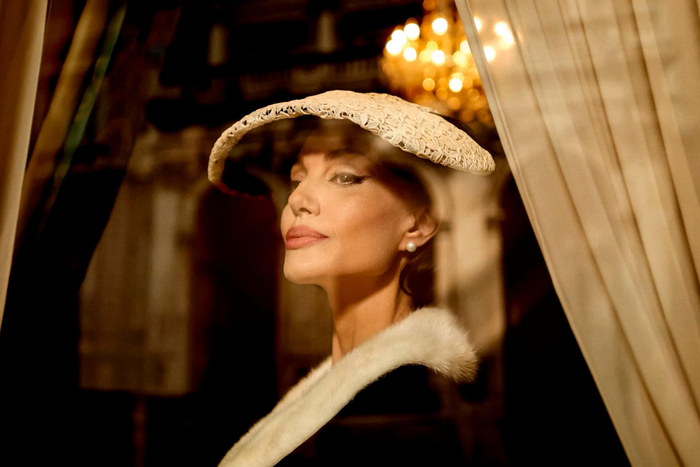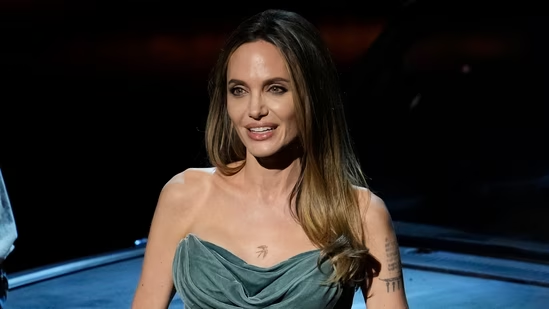Angelina Jolie grew emotional at the Venice Film Festival after her upcoming film, *Maria*, garnered an eight-minute standing ovation. Numerous videos and photographs of the actress at the event quickly circulated across social media platforms.
Angelina Jolie becomes tearful at the film festival.
At the event on Thursday evening, Angelina Jolie donned a custom beige gown by Tamara Ralph, complemented by a fur stole. When she became emotional, her *Maria* co-star, Pierfrancesco Favino, comforted her, and she was briefly seen resting her head on his shoulder. The film’s director, Pablo Larraín, also assisted her as she ascended the stairs, after which she bowed to the audience.
Fans proclaim her as a “Queen.”
In response to a video, one fan remarked, “She has endured so much, and receiving this recognition for her work must be incredible.” Another comment read, “A remarkable human being and a stunning woman.” One person wrote, “If there’s one celebrity I will always admire, it’s Angelina Jolie.” Another fan tweeted, “The queen has returned.” A different comment expressed, “I hope she wins the Oscar.”
About “Maria”
“Maria”, the 1977 Mexican drama directed by Leonardo Henríquez, unfolds the tale of a peasant girl, Maria, who falls in love with Rafael, the son of a wealthy farmer. As their romance flourishes, they find themselves entangled in the conflicts of societal class divisions and familial expectations. The film is celebrated for its captivating portrayal of Mexican landscapes and its exploration of themes such as love, social inequality, and tradition.

Her starring role in Maria is her most ambitious in ages, and yet it doesn’t feel like a reemergence.(Getty image)
In the film, Jolie’s portrayal of Maria is marked by countless moments of introspection, where the character gazes into the distance, lamenting the loss of her former self, her artistic presence, and her one true love, Aristotle Onassis—described by Jolie as “ugly and dead.” In the flashback scenes featuring Onassis, played by Turkish actor Haluk Bilginer, he appears as a shrewd figure in evening attire. Jolie’s every gesture exudes a tragic, trembling quality, and her smiles are faint and grand, as if she is detached from the world around her. This performance comes from the “Don’t hate me because I’m beautiful” school, presenting the final days of a great artist with a self-aware gloss that overshadows the genuine majesty and sorrow of Callas’s life.
The film “Maria” is crafted with great reverence and even a hint of adulation, but it lacks genuine emotional depth. This isn’t a reflection on Jolie’s performance; rather, the issue lies with the film’s execution. Director Pablo Larraín clearly has an affinity for his subjects and a particular fondness for depicting their suffering. However, he struggles to convey these emotions in anything beyond a sophisticated, yet superficial, manner. In contrast, Natalie Portman’s portrayal in “Jackie” managed to convey both the subject’s coldness and her concealed sorrow, despite the surrounding clever and artful filmmaking.”Maria” remains a revered classic in Mexican cinema.
Angelina on playing Maria Callas
In an interview with The Associated Press on Thursday, Angelina Jolie expressed her deep connection with the character she portrayed, saying, “I felt it was such a privilege to have the chance to know this woman and, for a brief moment, to inhabit her world. I genuinely care for her deeply, and I think I’ll carry that feeling with me as if she were a friend. When I wore her distinctive glasses, styled her hair in the Greek fashion, and dressed in my robe as an older woman, I felt connected to a side of Maria that the world never knew—a private Maria. I connected with her in that way and developed a kind of love for her.”
Jolie underwent nearly seven months of preparation for the role, and the singing in the film is a mix of her own voice and the real artist’s. She recalled, “In my first days, Larraín was very considerate, allowing me to start with a more intimate setting with very few crew members. We eventually moved to the grand stage of La Scala with a full audience, which gave me some time to build my confidence. But this is the most challenging thing I’ve ever done. I was absolutely terrified.”

